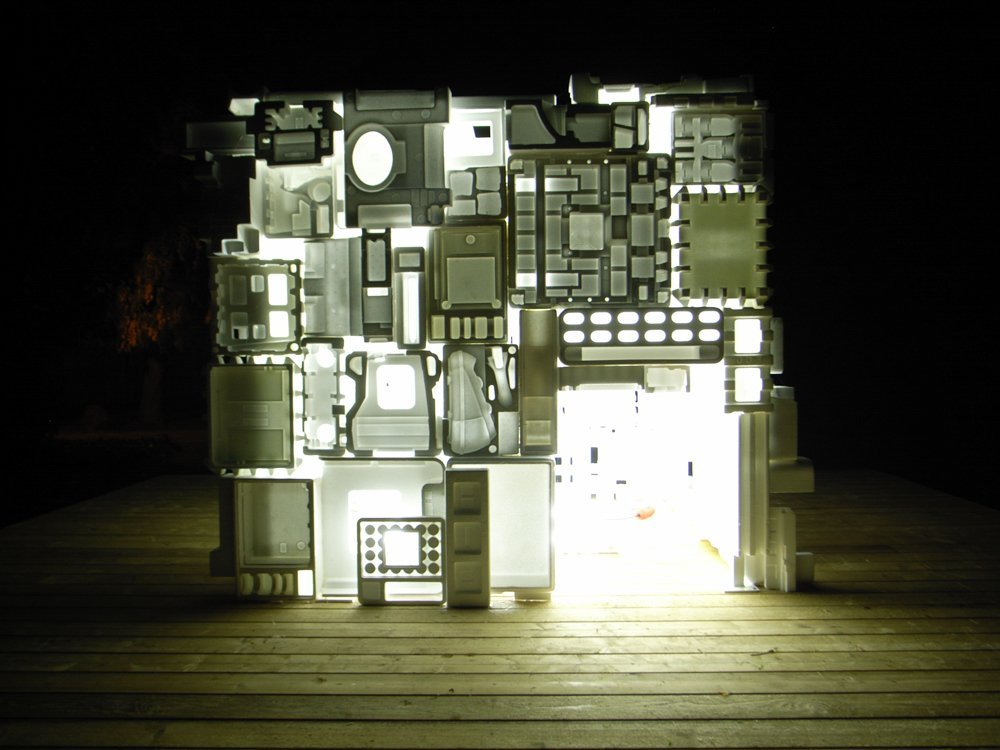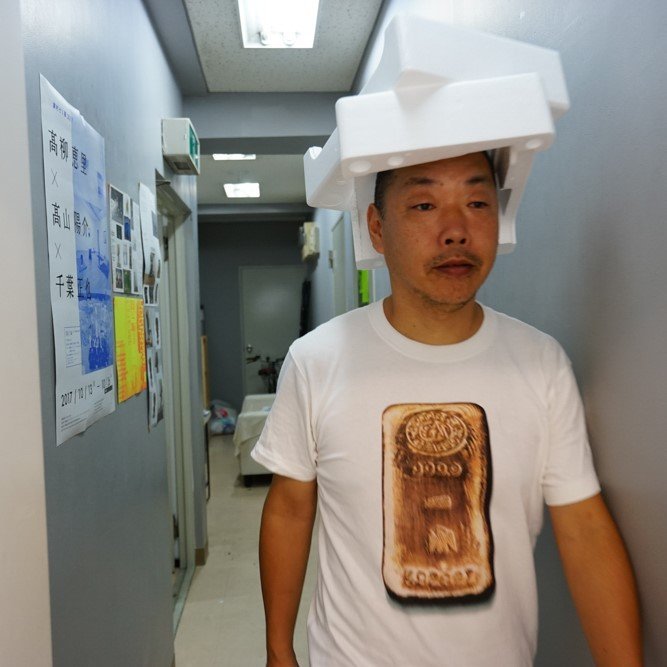
Yoshiaki Kaihatsu: ART IS LIVE―Welcome to One Person Democracy
Museum of Contemporary Art Tokyo is pleased to present Yoshiaki Kaihatsu: ART IS LIVE―Welcome to One Person Democracy, the first major exhibition dedicated to Yoshiaki Kaihatsu (1966–) held at a museum in Tokyo. Since the beginning of his career in the 1990s, the artist has devoted himself to artistic activities that involve and provoke communication, with underlying interest in familiar events, such as everyday life and social occurrences.
GUIDE MAP

ART IS LIVE, 2024. Photo: Yasunori Tanioka
The forms of expression he employs are diverse, ranging from the production of drawings, photographs, performances, and installations to everyday tasks, workshops at schools and in communities, and proposing and advocating Thank You Art Day, which designates March 9 (the pronunciation of “3 9” resembles “thank you” in Japanese) as the day to celebrate art. Among them, the ongoing projects offer us a glimpse into the philosophy behind his endeavors. Future Post Office, in which a letter you write to yourself or to your friend arrives after a year, 100 Teachers, in which classes are conducted under the slogan, “Everyone is a teacher, everyone is a student,” and Mole TV, which invites diverse guests to the underground studio, all mimic the existing formats—the postal service, education, and mass media—while suggesting an equal relationship between the message’s sender and receiver.
Dragon Chair, a workshop that started at school in Fuchu, invited children to express themselves—without worrying about what others think—through chairs, which are linked together to form a dozens-meter-long dragon. In 2011, the artist began a charity exhibition, Daylily Art Circus (2011, 2012, 2013, 2014), with his artist and personal friends. The project collected donations, traveling from Western Japan, the region struck by the Great Hanshin and Awaji Earthquake, to the areas affected by the Great East Japan Earthquake and Fukushima-Daiichi nuclear plant accident. His interaction with people in the disaster-stricken regions and experiences at the sites led to other projects in Fukushima, such as The House of Politicians (2012–) and Cotoba Library (Library of Words), which collects vanishing dialects. These projects, in which Kaihatsu hears individuals’ faint voices and calmly continues to do what he can do, can be described as “side-by-side activism.”

Future Post Office, Installation view at Shin Minatomura: A Small City for the Future, Yokohama Triennale 2011 Special Tie-Up Program (BankART Life III), 2011

Yoshiaki Kaihatsu Open Studio Program in Fuchu Art Museum, Collaborative Project Dragon Chair, 2008
Kaihatsu’s gestures of personally intervening in social structures, systems, communities, and events have come to characterize his practice: the late Osamu Ikeda (former director of BankART1929) called it “One Person Democracy*.” “Democracy,” a term premised on everyone’s participation, may seem to contradict “one person.” However, precisely because these movements are not united, individuals can react to each other, and the reaction successively involves people and results in an action. This is where we find the core of Kaihatsu’s artistic expression.
Many of his extensive and diverse artistic activities are not intended to be in a collection or exhibited at museums, and this has limited opportunities to overview his career of over thirty years. Yoshiaki Kaihatsu: ART IS LIVE―Welcome to One Person Democracy presents about fifty pieces of works and projects by the artist, who has confronted everyday events and social changes firsthand. We welcome viewers to the world of One Person Democracy.
*Osamu Ikeda, “One Person Democracy,” KAIHATSU Yoshiaki, BankART1929, 2014

Happo-en in Winterthur, Winterthur City/Switzerland, 2007

The House of Politicians, Minami Soma/FUKUSHIMA, 2012
Yoshiaki Kaihatsu| Profile
-

Yoshiaki Kaihatsu
Born in Yamanashi Prefecture in 1966. In 1993, Kaihatsu completed a Master’s degree in Arts at Tama Art University. He received a grant from the Asian Cultural Council and stayed in New York and Berlin, creating and presenting works. He received the 4th Taro Okamoto Award for Contemporary Art, Outstanding performance award in 2001 and participated in the 9th International Architecture Exhibition La Biennale di Venezia in 2004. He started Thank You Art Day, which designates March 9 as the day to celebrate art, and organizes Daylily Art Circus, a disaster relief activity. His recent solo exhibitions include 8th Grade Syndrome (2016, Ichihara Lakeside Museum), AREKORE KAIHATSU FACTORY (2019, The Hakone Open-Air Museum), and Kaihatsu Rediscovering, Vol. 1, 2, 3 (2019, 2022, ANOMALY), and group exhibitions include Echigo Tsumari Art Triennial (2006–), ICHIHARA ART x MIX (2014–), and Now, it’s time to play (2019, Museum of Contemporary Art Tokyo).
Highlights
-

Performance at Documenta 9, 1992. Photo: Kazushiro Namai
Materials from Kaihatsu’s early career not shown anywhere else
The exhibition introduces a number of photographs, videos, and actual materials of Kaihatsu’s ambitious early-career activities, including those presented publicly for the first time, such as his guerrilla performance at Documenta 9 and 365 PROJECT, which traveled through Japan between 1995 and 1996.
-
An Oasis for City‐Dwellers, ZOOM ZEXEL ART SPACE/Tokyo, 2020. Photo: Yasunori Tanioka
A little strange Kaihatsu Town
A part of the exhibition gallery called Kaihatsu Town showcases a collection of unique facilities, such as a post office that delivers letters a year later, a bank that does not deal money, and a classroom that offers unusual classes. If you get tired, you can take a break in a faux fur park.
-

Useless Panda in Kiba
Live art experience
The artist is in the exhibition room every day, doing something (he can be absent occasionally). Something happens daily, and visitors can witness or participate in the events. Various activities, including 100 Teachers, which invites a hundred unique and interesting teachers to give a hundred unique classes during the exhibition, as well as talk events with collaborators from projects in Tohoku and Thank You Art Day, live performances, and workshops, are given in the exhibition room and the museum’s premise every day, creating a place for movement, transformation, meeting, and conversation
Information
- Exhibition Period
Saturday, August 3 – Sunday, November 10, 2024
- Closed
Mondays (except 12 Aug., 16 and 23 Sep., 14 Oct., 4 Nov.), 13 Aug., 17 and 24 Sep., 15 Oct., and 5 Nov.
- Opening Hours
10 AM – 6 PM (Tickets available until 30 minutes before closing)
*Open until 8 PM on November 8 and 9- Venue
Museum of Contemporary Art Tokyo Exhibition Gallery 3F
- Admission
Adults - 1,500 yen / University & College Students, Over 65 - 1,100 yen / High school & Junior High School Students - 600 yen / Elementary School Students & Younger - free
*20% discount for a group of over 20 people.
*Ticket includes admission to the MOT Collection exhibition.
*Persons with a Physical Disability Certificate, Intellectual Disability Certificate, Intellectual Disability Welfare Certificate, or Atomic Bomb Survivor Welfare Certificate as well as up to two attendants are admitted free of charge.
[Silver Day] Those over 65 years old receive free admission on the third Wednesday of every month by presenting proof of age at the ticket counter.
[Summer Night Museum 2024]
Special discount for admissions after 5 PM on August 9, 16, 23 and 30.
Students: Free with valid identification / Adults & over 65: 20% discount with valid identification
[Students Day supported by Bloomberg]
Students can view the exhibition for free by presenting a valid ID at the museum's ticket counter on September 7 and 8.- Organized by
Museum of Contemporary Art Tokyo operated by Tokyo Metropolitan Foundation for History and Culture
- Sponsored by
TOKYU KABUKICHO TOWER / HOTEL GROOVE SHINJUKU, A PARKROYAL Hotel

- Grant
The Mitsubishi UFJ Trust Cultural Foundation
- In cooperation with
GRANTCHESTER HOUSE




